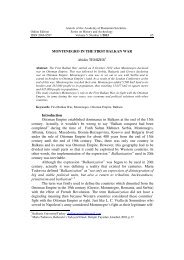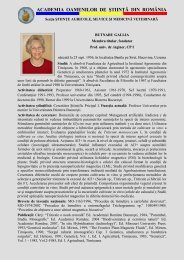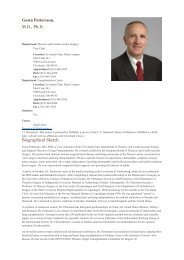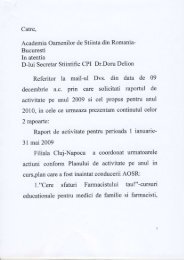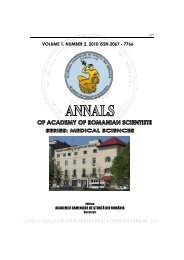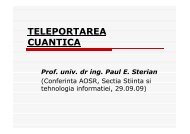Volume 3 nr 1 / 2011 - Academia Oamenilor de Stiinta din Romania
Volume 3 nr 1 / 2011 - Academia Oamenilor de Stiinta din Romania
Volume 3 nr 1 / 2011 - Academia Oamenilor de Stiinta din Romania
- No tags were found...
Create successful ePaper yourself
Turn your PDF publications into a flip-book with our unique Google optimized e-Paper software.
Critical Infrastructures ProtectionA <strong>Romania</strong>n Perspective (Part 1) 115However, the critical infrastructures know a certain dynamic, some can becomecritical, others, protected a<strong>de</strong>quately, can exit this category.The European Commission suggests three essential criteria for the i<strong>de</strong>ntificationof potentially critical infrastructures: Extent or surface. The <strong>de</strong>terioration of the critical infrastructure isevaluated <strong>de</strong>pen<strong>din</strong>g on the geographical region which would sufferconsequences; the international, national, regional/ territorial or local dimension; The <strong>de</strong>gree of seriousness. The inci<strong>de</strong>nce or <strong>de</strong>gradation can be null,minimal, mo<strong>de</strong>rate or high. The main criteria for the evaluation of the <strong>de</strong>gree ofseriousness: economic inci<strong>de</strong>nce, inci<strong>de</strong>nce on the public, inci<strong>de</strong>nce on theenvironment, <strong>de</strong>pen<strong>de</strong>nce, political inci<strong>de</strong>nce; Effect in time. This criterion shows the moment in which the <strong>de</strong>gra<strong>din</strong>g ofthe infrastructure can have a major inci<strong>de</strong>nce or a serious effect – immediately,after 24-48 hours, in a week or within a longer period of time.It is the duty of every state that it i<strong>de</strong>ntifies through the governmental structuresthe critical infrastructures on its territory. However, the European states are notalone, isolated, but in extremely tightly knit, complex relationships. The absolutein<strong>de</strong>pen<strong>de</strong>nce concept has disappeared a long time ago. Europe becomes more andmore inter<strong>de</strong>pen<strong>de</strong>nt and responsible for everything which is going on, not only ininternational relations, but also on the territory of each state.This is why the process of i<strong>de</strong>ntifying, analysing, evaluating and securing(protecting) critical infrastructures cannot be fragmented, and, even less, isolated.If a single state does not comply with its obligations to i<strong>de</strong>ntify, the criticalinfrastructures on its territory, and to take the necessary measures for themitigation of their vulnerabilities, for countering the threats and ensuring thenecessary protection and security standards, the effects will be felt, one way oranother, by all the other states. In other words, the responsibility for i<strong>de</strong>ntifying,evaluating, protecting and securing critical infrastructures becomes in the contextof increased inter<strong>de</strong>pen<strong>de</strong>ncy and the proliferation of threats, a vital aspect for thegood functioning of human society. This is another important conclusion for themanagement of critical infrastructure security.The international dimension of this responsibility resi<strong>de</strong>s in the following reality: Most of critical infrastructures, or those that can become critical,outreaches the geographical area of one state; The increase of the vulnerabilities of critical infrastructures of one state<strong>de</strong>termines, one way or another, the raising of vulnerabilities of all infrastructuresin the area and/or network;Copyright © Editura Aca<strong>de</strong>miei <strong>Oamenilor</strong> <strong>de</strong> Știință <strong>din</strong> România, <strong>2011</strong>Watermark Protected



